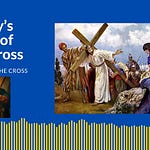🕊️ The Bread of Life Discourse: Heaven’s Gift of Christ in the Eucharist
One of the most powerful and controversial teachings of Jesus is found in John 6—commonly referred to as the Bread of Life Discourse. In it, Jesus doesn’t just feed the crowd with multiplied loaves; He reveals that He Himself is the true and living Bread come down from Heaven. This moment is more than metaphor—it is the heart of Catholic faith in the Eucharist, where Christ gives us His very Body and Blood.
✝️ "I Am the Bread of Life" – John 6:35
After feeding the five thousand, the crowds seek Jesus again. But rather than offer another meal, Jesus tells them to hunger for the food that endures for eternal life (John 6:27). That food, He proclaims, is Himself.
“I am the bread of life. Whoever comes to me will never be hungry, and whoever believes in me will never be thirsty.” (John 6:35)
In this declaration, Jesus draws a parallel between the manna God gave the Israelites in the wilderness and a new bread from Heaven—Himself, the true and eternal nourishment.
🕯️ From Faith to Flesh
At first, Jesus speaks of believing in Him as the path to eternal life. But He takes it further—shockingly so.
“The bread that I will give for the life of the world is my flesh.” (John 6:51)
The reaction is immediate. Confusion. Disbelief. Even among His disciples.
“How can this man give us his flesh to eat?” (John 6:52)
Yet rather than soften His language, Jesus intensifies it:
“Whoever eats my flesh and drinks my blood has eternal life... For my flesh is true food and my blood is true drink.” (John 6:54-55)
These are not symbolic statements. The Catechism of the Catholic Church teaches that Christ is “truly, really, and substantially” present in the Eucharist—not as a metaphor, but as a sacramental reality (CCC 1374).
🛐 Communion: Not Just Remembering, But Receiving
Jesus reveals that this “eating” of His flesh is not merely about faith, but about a sacramental union with Him:
“Whoever eats my flesh and drinks my blood remains in me and I in him.” (John 6:56)
The Eucharist is the fulfillment of this promise. It is the moment in which we are united with the crucified and risen Christ, made participants in His Paschal Mystery.
As the Catechism explains:
“Communion with the body and blood of Christ increases the communicant’s union with the Lord, forgives his venial sins, and preserves him from grave sins.” (CCC 1416)
💔 A Dividing Line: Will You Also Leave?
As the discourse concludes, many walk away. Jesus has not softened the message to keep them. Instead, He turns to His closest followers:
“Do you also wish to go away?” (John 6:67)
Peter responds with words that echo across centuries:
“Lord, to whom shall we go? You have the words of eternal life.” (John 6:68)
This moment marks the beginning of the Church’s deep devotion to the real presence of Christ in the Eucharist—a belief not invented centuries later, but rooted directly in Christ’s own words.
📖 Catechism Highlights
CCC 1324 – The Eucharist is the “source and summit” of the Christian life
CCC 1374 – Christ’s real, substantial presence in the Eucharist
CCC 1392 – The Eucharist unites us with Christ, nourishes grace, and strengthens charity
CCC 1415 – A soul must be properly disposed to receive such a great sacrament
✨ Final Reflection
The Bread of Life Discourse is a radical call to faith, intimacy, and sacramental communion. It challenges us, just as it did those first hearers. But it also invites us into the deepest mystery of divine love—a God who does not only speak to us from Heaven but gives Himself to us as food for the journey.
Jesus is not just the giver of bread. He is the Bread.













Share this post